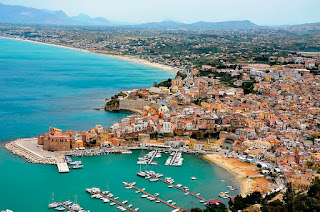 |
| The Chiesa Madre in Palma di Montechiaro had similarities with Noto cathedral |
The architect and Jesuit friar Angelo Italia, who was an important protagonist in the development of Sicilian Baroque as an architectural style, was born on this day in 1628 in Licata, a town on the southern coast of Sicily, about 45km (28 miles) east of Agrigento.
In later life, Italia was one of the architects commissioned to work on the rebuilding of cities in the south-eastern corner of the island, following the devastating earthquake of 1693.
He was particularly influential in the design of the reconstructed cities of Avola and Noto, where the beauty of the architecture still attracts tens of thousands of visitors each year.
Individual buildings attributed to Italia include the Chiesa di San Francesco Saverio in Palermo, the Chapel of the Crucifix in the cathedral at Monreale, and the Chiesa Madre Maria Santissima del Rosario in Palma di Montechiaro, not far from Licata, with a facade flanked by two bell towers, at the top of a long, scenic staircase, similar to that which characterises the impressive cathedral in Noto.
He became a Jesuit friar in 1671 and resided in the Jesuit College in Palermo, where he died in 1700 a few days before what would have been his 72nd birthday.
Italia’s background is not documented with certainty but his father, Francesco, is thought to have been a master bricklayer and contractor in Licata, where Angelo likely began his career as a stonemason before beginning to take on design projects.
 |
| The design of the church of San Francesco Saverio in Palermo is attributed to Angelo Italia |
Some architectural historians believe elements of Italia’s work point to him having spent some time in Rome, suggesting detailed knowledge of the works of Francesco Borromini and Girolamo Rinaldi, who were both contemporaries, can only have been acquired by having travelled to the city, although no evidence has been uncovered that he did.
Before he joined the Jesuit order, Italia is thought to have worked primarily with his father around Licata. Stylistic elements of the church of Sant'Angelo Carmelitano in Licata, especially the facade, suggests that this may have been his debut project in around 1653.
After he entered the order, he would primarily have worked in the service of the order, as was customary. His projects in Palermo at that time included the churches of San Francesco Saverio and Del Gesù, the second of which was destroyed in World War Two.
 |
| The cathedral at Noto, where Italia was closely involved in reconstruction work |
After the earthquake of 1693 that flattened large areas of south-eastern Sicily, destroying or severely damaging at least 70 towns and cities, including Catania, Siracusa, Noto and Acireale, Italia was among many architects called upon to assist in the reconstruction. Italia worked primarily in Avola, Lentini and Carlentini, and Noto.
In Avola, while he left the building work to others, Italia designed a grid of streets within a hexagonal square, with walls, bastions and moats, although these no longer exist. He also moved to city from its original location to a flat area nearer to the sea.
His designs for Lentini and Carlentini, two neighbouring towns between Catania and Siracusa, also involved relocating the towns from their original sites. The relocation was rejected and although new urban areas were built on the original sites, the expense involved dwarfed Italia’s original plan.
Italia’s involvement in the Noto project is unclear, with other architects and engineers given credit for different elements, but it seems to be accepted that moving the city from its original location to another 8km (5 miles) away was Italia’s suggestion, as was following an urban plan based on Palma di Montechiaro.
.jpg) |
| Sandy beaches and rocky coves are a feature of the coastline around Licata |
Licata, where Angelo Italia was born, is a seaside resort and an important port situated on the southern coast of Sicily between Agrigento and Gela. Some 20km of seafront, a mix of sand and pebble beaches and reefs to the west, is a major pull for tourists but the town also has much history, having been at times under the control of the Phoenicians, the Carthaginians, the Romans, the Byzantines, the Arabs, the Saracens, the Normans, the Turks, the Spanish and the French. Current attractions include the Castel Sant’Angelo, built by the Spanish, and the remains of an ancient Greek acropolis. The main church is Santa Maria La Nova, built in the 15th century, and there are several interesting Liberty-style buildings including the Palazzo di Città, designed by Ernesto Basile, the Teatro Re Grillo and the Parco delle Ville Liberty.
 |
| The Castello di Montechiaro is now a sanctuary dedicated to the Madonna del Castello |
Built on a hill overlooking a valley, which stretches down to the sea, Palma di Montechiaro enjoyed some fame as a fiefdom of Donnafugata in the novel The Leopard. The village is renowned for its mother church, Chiesa Madre Maria Santissima del Rosario in Palma di Montechiaro, which Italia designed and is considered to be among the most iconic examples of Sicilian Baroque architecture. Also notable are the Ducal Palace, a Benedictine Monastery and the Castello di Montechiaro, now a sanctuary dedicated to the Madonna del Castello, and Torre San Carlo, a four-sided tower on a base shaped like a truncated pyramid. The Chiesa Madre, designed by Angelo Italia, bears many similarities with the cathedral at Noto, which was part of Italia’s plans for the reconstruction of that city after the earthquake of 1693.
Also on this day:
1587: The birth of Victor Amadeus I of Savoy
1639: The birth of painter Giovanni Battista Gaulli
1898: Italy’s first football championship
1960: The birth of footballer Franco Baresi
.jpg)





_-001.jpg)

.jpg)



_-_Exterior.jpg)



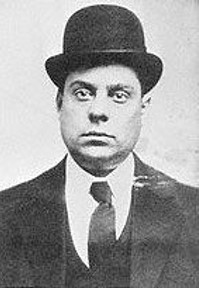
.jpg)
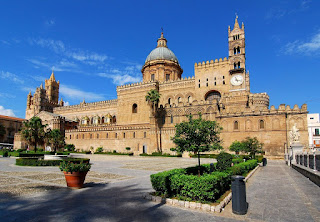
.jpg)

.jpg)


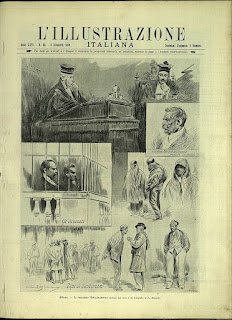

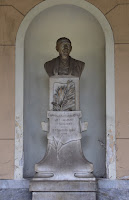




.jpg)
